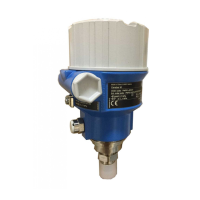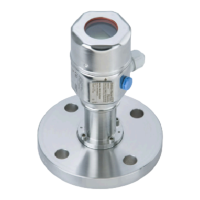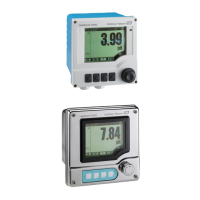Gammapilot M
Endress+Hauser 7
Description of safety requirements and boundary
conditions
Safety function The safety function of the measuring system is maximum point level detection (overfill protection).
The radiometric measuring system does not come into contact with the medium.
!
Note!
To activate the safety functions, the Gammapilot M must be locked directly after calibration (see Section
"Method for device parameterization" → ä 15).
Safety-related signal:
The safety-related signal of the Gammapilot M is the analog output signal 4 to 20 mA.
All safety measures are based exclusively on this output.
In addition, the Gammapilot M communicates non safety-related informations via HART and contains all
HART characteristics with additional device information.
The Gammapilot M generates an analog signal (4 to 20 mA) proportional to the pulse rate. This signal is sent
to a logic unit located downstream, e.g. a programmable logic controller or a limit signal transmitter, and
monitored there to establish if:
• a predefined level limit is exceeded
• an error occurs (e.g. error current in accordance with NE 43 (≤ 3.6 mA, ≥ 21 mA, interruption or short-
circuiting of signal line).
In addition to the analog signal path for the output current, the Gammapilot M has a redundant, internal, digital
signal path. Both paths are monitored permanently by the Gammapilot M. This results in the following behavior
of the output current:
SD230en05
• Electronic partial stroke test (analog signal path test):
This is a cyclical life test of the analog signal path. For this test, the output current is increased by 10 % of
the measuring range (1.6 mA) up to a maximum of 20 mA every 2 minutes for 15 seconds.
Safe point level detection is not affected by the hysteresis that has to be configured in the PLC
(see "Configuration of switch point and hysteresis" → ä 17).
This signal path can be used to permanently monitor and detect the correct safety-related configuration and
correct functioning of the Gammapilot M.
• Digital signal path test:
This is a cyclical life test of the digital signal path. For this test, the output current is set to a value
< 3.6 mA (typically 2.4 mA) every 2 minutes for 250 ms. The evaluation unit located downstream must be
configured in such a way that this test is not interpreted as a signal on alarm.
According to NE 43 §7, for example, a signal on alarm is not to be recognized as such unless it lasts at least
4seconds.
15 s
250 ms
+1,6 mA
Electronic partial stroke test
(analog signal path test)
Digital signal path test
Analog signal 4...20 mA
Time t
Current
< 3.6 mA
(typically
2.4 mA)

